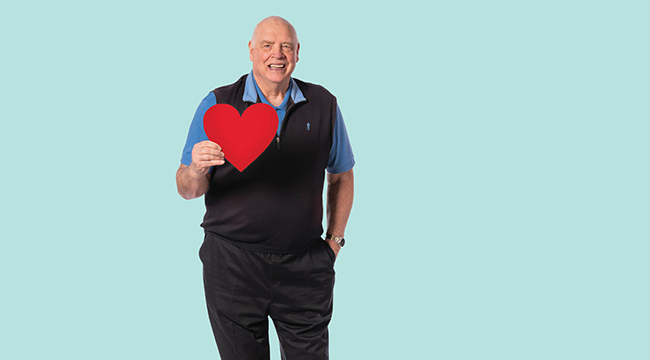“Since my surgery, I’ve felt comfortable and confident knowing this device is in there protecting me from blood clots.”
As a retired Major League pitcher and coach of 32 years, Steve Renko (pictured above) of Leawood knows a lot about timing—just a minor adjustment in grip and technique can make a big difference in a player’s fastball. Similarly, when his heart rhythm became irregular 10 years ago because of a condition called atrial fibrillation (a-fib), the altered timing led to fatigue, shortness of breath and lightheadedness.
 Steve made an appointment with Ravi Yarlagadda, MD, FACC, a board-certified electrophysiologist with Olathe Health Cardiology Services.
Steve made an appointment with Ravi Yarlagadda, MD, FACC, a board-certified electrophysiologist with Olathe Health Cardiology Services.
“Atrial fibrillation is an erratic heart rhythm that increases the risk of stroke due to the formation of blood clots in the heart,” Dr. Yarlagadda said.
Dr. Yarlagadda implanted a pacemaker in Steve’s chest to help send electrical impulses to the heart to prompt it to beat at a normal pace. He also prescribed blood-thinning medications to reduce Steve’s risk of stroke.
The treatment was successful for a number of years, and Steve enjoyed an active retired life on the golf course, eating out with friends and enjoying time at home with his wife, Sandra. That changed in mid-2018, when Steve started to develop large, painful bruises on his body. One area on his leg was so large and painful that Steve and his wife called for an ambulance one night. The bruising was a side effect of the blood thinners.
“We had to take Steve off the blood thinning medication, but we still needed to address his high risk of stroke. That’s when we started talking about the new left atrial appendage (LAA) closure procedure as an option,” Dr. Yarlagadda said.
In this procedure, a device is implanted that permanently seals off the LAA, the section of the heart where blood clots often form in people who have a-fib. It prevents blood clots from entering the bloodstream and causing a stroke. The device is inserted into the heart via a catheter placed in a vein in the upper leg. Once in place, the mesh device opens like an umbrella. Patients typically spend one night in the hospital and return home the following day.
“Being able to offer new techniques and procedures at Olathe Health like the LAA closure make it possible for us to help even more patients—including those who might not be candidates for other procedures or treatments,” Dr. Yarlagadda said. “It means we can often help people who didn’t have options before.”
Dr. Yarlagadda performed the LAA closure procedure in Steve’s heart late last year. Steve’s pacemaker still helps keep his heart rhythm in check, and he no longer has to take blood-thinning medication.
“Since my surgery, I’ve felt comfortable and confident knowing this device is in there protecting me from blood clots,” Steve said. “I’ve known Dr. Yarlagadda for more than 10 years, and have gotten to know everyone in his office and in the cath lab. I trust them, and am glad they’ve been looking out for me for so long.”
Steve is feeling good again, and after a long winter is eager to spend spring back on the golf course.
LAA Closure Procedure is Alternative for A-fib Patients on Blood Thinners
If you have atrial fibrillation (a-fib), not caused by a heart valve problem, and you’re looking for an alternative to blood thinners, you might be a candidate for Olathe Health’s new non-invasive procedure called left atrial appendage (LAA) closure. It is an effective way to reduce the risk of stroke for people with A-fib.
At Olathe Health, a multi-disciplinary team works together on each patient’s care plan. This includes the electrophysiologist (EP), interventional cardiologist, imaging cardiologist and EP coordinator – all within the same health system.
To see if this procedure is right for you, ask your primary care doctor for a referral to an electrophysiologist, or call 913-780-4900.

